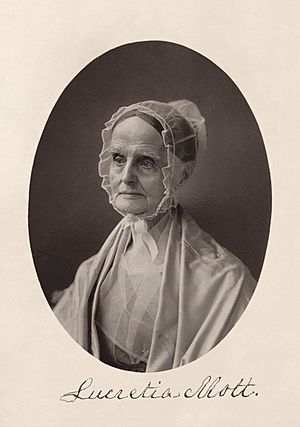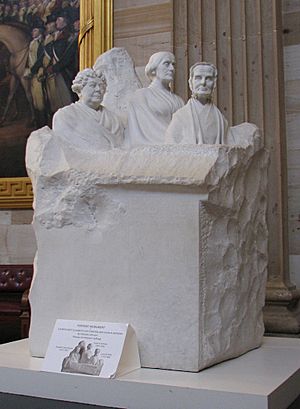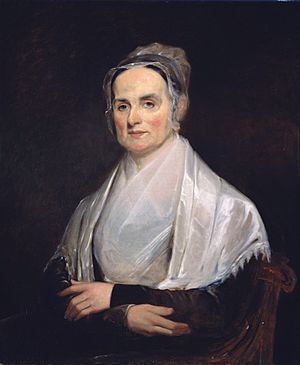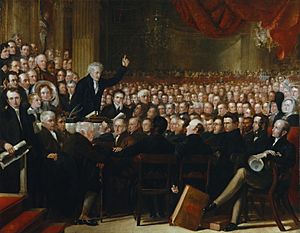Lucretia Mott facts for kids
Quick facts for kids
Lucretia Mott
|
|
|---|---|

Photograph of Lucretia Mott, ca. 1870-1880 (Aged roughly 77-87)
|
|
| Born |
Lucretia Coffin
January 3, 1793 Nantucket, Massachusetts, U.S.
|
| Died | November 11, 1880 (aged 87) La Mott, Cheltenham, Pennsylvania, U.S.
|
| Occupation | Abolitionist, suffragist, teacher |
| Spouse(s) | James Mott (m.1811, died 1868) |
| Children | 6 |
| Parent(s) | Thomas Coffin Anna Folger |
| Relatives | Martha Coffin Wright (sister) Mayhew Folger (maternal uncle) Levi Coffin (cousin) |
Lucretia Mott (born Lucretia Coffin; January 3, 1793 – November 11, 1880) was an important American Quaker, abolitionist, and women's rights activist. She worked to end slavery and fought for equal rights for women. She became a Quaker preacher early in her life.
Mott started thinking about women's rights when she was not allowed to participate in the World Anti-Slavery Convention in London in 1840. Later, in 1848, she helped organize the first public meeting about women's rights. This meeting was called the Seneca Falls Convention. During this event, Mott helped write the Declaration of Sentiments, a document that called for women's equality.
Because she was a great speaker, Lucretia Mott became a key leader in movements for ending slavery, women's rights, and other social changes. After slavery was outlawed in the United States in 1865, she argued that former slaves, both men and women, should have the right to vote. She remained a central figure in these important movements until her death in 1880. The area where she lived for a long time is now named La Mott in her honor.
Contents
Early Life and Education
Lucretia Coffin was born on January 3, 1793, in Nantucket, Massachusetts. She was the second child of Anna Folger and Thomas Coffin.
When she was 13, Lucretia went to the Oakwood Friends School in New York. This school was run by the Society of Friends. After she graduated, she became a teacher there. Her interest in women's rights began when she found out that male teachers were paid much more than female teachers. After her family moved to Philadelphia, she and James Mott, another teacher from the school, followed them.
Fighting Against Slavery
Like most Quakers, Mott believed that slavery was wrong. She and other Quakers refused to buy goods made by enslaved people, such as cotton cloth and cane sugar. In 1821, Mott became a Quaker minister. She traveled widely, giving sermons that spoke about the "inward light" within every person. Her sermons also included her strong feelings against slavery.
In 1833, her husband helped start the American Anti-Slavery Society. Lucretia Mott was the only woman to speak at their first meeting in Philadelphia. She helped make sure the society's rules were strong. Soon after, Mott and other women, both white and Black, founded the Philadelphia Female Anti-Slavery Society. This group worked against both slavery and racism. Mott often preached in Black churches.
Mott continued her work against slavery despite challenges. She managed her home and welcomed fugitive slaves as guests. She also gave money to charities. People praised her for being able to manage her household while also working for such an important cause.
Mott and other women also organized anti-slavery fairs. These fairs helped raise awareness and money for the movement.
Many people at the time did not approve of women speaking in public. Some religious leaders even warned women not to speak in church. However, Mott continued her work. She attended three national Anti-Slavery Conventions of American Women. In 1838, during a convention in Philadelphia, a mob destroyed Pennsylvania Hall, where the meeting was held. Mott and other delegates, linking arms, safely left the building. The mob then targeted her home, but she was ready to face them.
Mott was part of many anti-slavery groups. These included the Philadelphia Female Anti-Slavery Society and the American Anti-Slavery Society.
World's Anti-Slavery Convention
In June 1840, Mott went to the World's Anti-Slavery Convention in London, England. Even though she was one of six women delegates, the men at the conference voted to stop the American women from participating. The female delegates had to sit in a separate area. Some anti-slavery leaders did not want the issue of women's rights to distract from the main goal of ending slavery. Also, it was not common for women to be fully involved in public political life at that time.
Several American men at the convention, like William Lloyd Garrison, protested this decision. They sat with the women in the segregated area.
Elizabeth Cady Stanton and her husband also attended the convention. Stanton admired Mott, and they became close friends and allies.
Mott returned from England with new energy for the anti-slavery cause in the United States. She and her husband used their home in Philadelphia, called Roadside, as a stop on the Underground Railroad. This was a secret network that helped enslaved people escape to freedom.
She continued to give public lectures in cities like New York City and Boston. She also traveled to states where slavery was legal, speaking in places like Baltimore and cities in Virginia. She even met with slave owners to discuss why slavery was wrong. In Washington, D.C., Mott gave a lecture when Congress was back from Christmas break. More than 40 Congressmen attended. She even met with President John Tyler.
Women's Rights
Lucretia Mott and Elizabeth Cady Stanton became good friends at the World's Anti-Slavery Convention. They first talked about holding a women's rights convention in London.
Women's rights activists fought for many issues. These included equal rights in marriage, such as women owning their own property and keeping their earnings. At that time, it was very hard for women to get a divorce. Fathers almost always got custody of children. Cady Stanton wanted to make divorce easier and protect women's rights to their children.
In 1866, Mott joined Stanton and others to create the American Equal Rights Association. This group worked for equal rights for all. Mott also helped found the Northern Association for the Relief and Employment of Poor Women in Philadelphia in 1846.
Seneca Falls Convention
In 1848, Mott and Cady Stanton organized the Seneca Falls Convention. This was the first women's rights convention. It took place in Seneca Falls, New York. At this meeting, Stanton proposed that women should have the "sacred right to the elective franchise," meaning the right to vote. Mott initially disagreed because she saw politics as corrupt. However, she soon realized that women should have the right to vote, whether they chose to use it or not. Mott signed the Declaration of Sentiments at the convention.
Even before the convention, Mott's fame had reached the political world. In June 1848, during the National Convention of the Liberty Party, some delegates voted for Lucretia Mott to be their party's candidate for U.S. Vice President.
Over the next few decades, women's suffrage (the right to vote) became the main focus of the women's rights movement. Mott's guidance and work with Cady Stanton were a big inspiration for this movement. Mott's sister, Martha Coffin Wright, also helped organize the convention and signed the declaration.
Frederick Douglass, a famous abolitionist, also attended the convention. He helped convince others to agree to the resolution calling for women's right to vote.
Discourse on Women
In 1850, Mott published a speech called Discourse on Woman. This was a pamphlet about the limits placed on women in the United States.
American Equal Rights Association
After the American Civil War, Mott was chosen as the first president of the American Equal Rights Association. This group supported universal suffrage, meaning the right to vote for everyone. She left the association in 1868. This happened when Elizabeth Cady Stanton and Susan B. Anthony teamed up with a controversial businessman. Mott tried to bring together the two groups that split over whether women's suffrage or Black male suffrage should be the main goal. Mott always tried to be a peacemaker.
Swarthmore College
In 1864, Mott and other Quakers helped create Swarthmore College near Philadelphia. Today, it is still one of the best liberal arts colleges in the country.
Pacifism
Lucretia Mott was a pacifist, meaning she believed in peace and opposed war. In the 1830s, she attended meetings of the New England Non-Resistance Society. She was against the War with Mexico. After the Civil War, Mott worked even harder to end war and violence. She was a leading voice in the Universal Peace Union, which was founded in 1866.
Personal Life
On April 10, 1811, Lucretia Coffin married James Mott in Philadelphia. They had six children, but their second child died young. Their other children all became active in the anti-slavery and other reform movements, just like their parents.
Lucretia Mott died on November 11, 1880, from pneumonia. She passed away at her home, Roadside, in the area now known as La Mott, Pennsylvania. She was buried in Fair Hill Burial Ground, a Quaker cemetery in North Philadelphia.
Legacy

When Lucretia Mott died in 1880, many people thought she was the greatest American woman of the 1800s. She was a mentor to Elizabeth Cady Stanton, who continued her important work.
A version of the Equal Rights Amendment from 1923 was named the Lucretia Mott Amendment. This draft said, "Men and women shall have equal rights throughout the United States."
The Camp Town area of Cheltenham Township, Pennsylvania, where Mott's home was, was renamed La Mott in her honor in 1885.
The United States Postal Service issued a stamp in 1948. This stamp celebrated 100 years since the Seneca Falls Convention. It featured Elizabeth Cady Stanton, Carrie Chapman Catt, and Lucretia Mott.
In 1983, Mott was added to the National Women's Hall of Fame.
Mott is honored along with Elizabeth Cady Stanton and Susan B. Anthony in a sculpture called Portrait Monument. This sculpture, made in 1921 by Adelaide Johnson, is in the United States Capitol.
The Lucretia Mott School in Washington D.C. was named for her. Another school, P.S. 215 Lucretia Mott in Queens, New York City, was also named after her.
In 2016, the United States Department of the Treasury announced that an image of Mott will appear on the back of a new $10 bill. She will be shown with other important women like Sojourner Truth, Susan B. Anthony, Elizabeth Cady Stanton, and Alice Paul.
See also
 In Spanish: Lucretia Mott para niños
In Spanish: Lucretia Mott para niños
Images for kids





